Last month in Cooper Hewitt Short Stories, we galloped through Sarah’s equestrian passion. In November’s short story, written by Matilda McQuaid, Deputy Curatorial Director and Head of Textiles at Cooper Hewitt, the sisters receive an important gift to their museum’s collection from family friend, J.P. Morgan.
Margery Masinter, Trustee, Cooper Hewitt, Smithsonian Design Museum
Sue Shutte, Historian at Ringwood Manor
Matthew Kennedy, Publishing Associate, Cooper Hewitt, Smithsonian Design Museum
“Intense Quality”
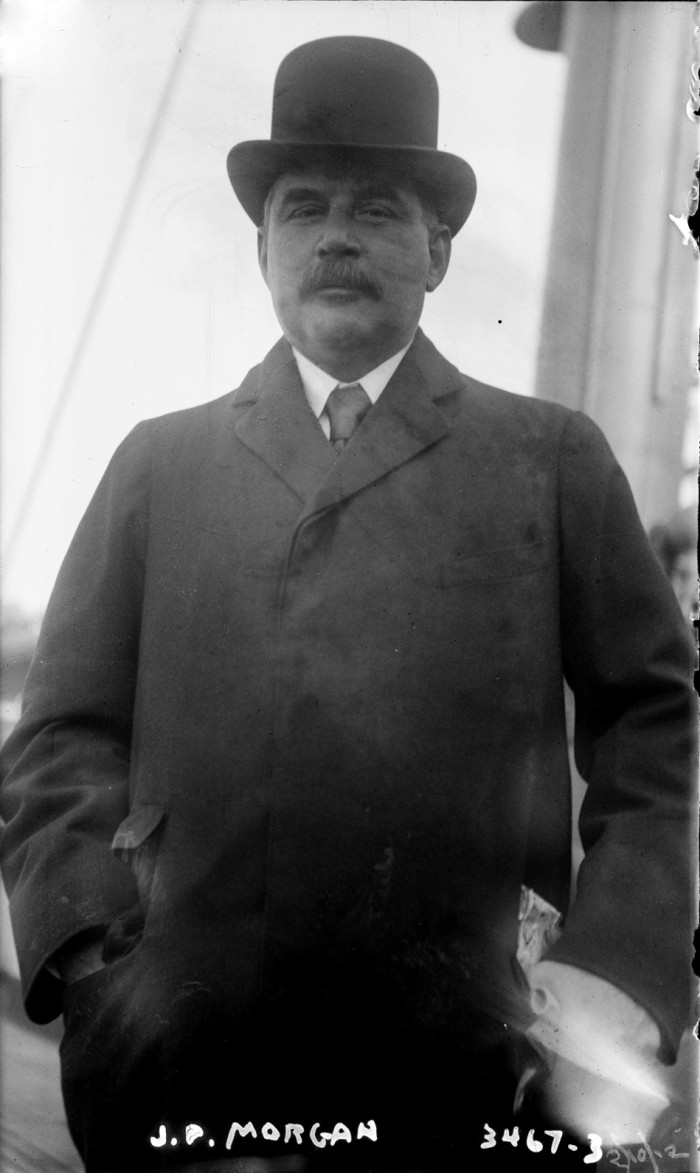
John Pierpont Morgan. Library of Congress Prints and Photographs Division Washington, D.C. 20540 USA.
In 1902, the prominent New York financier and industrialist John Pierpont Morgan donated more than one thousand textiles, including rare examples of Italian Renaissance velvets and Coptic, Mamluk, early Islamic, and Hispano-Moresque silks, spanning the thirteenth to eighteenth centuries. Morgan was not a textile collector, but purchased three major European collections—the Antonio Vivès y Escudero (1859–1925) collection in Madrid, the Miquel y Badía (1840–1899) collection in Barcelona, and the Stanislas Baron (d. 1910) collection in Paris—as a gift to the daughters of his friend, Abram Hewitt, who were establishing their Museum for the Arts of Decoration of Cooper Union.
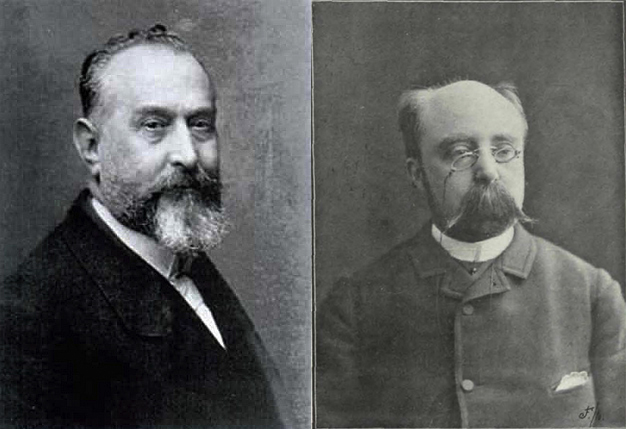
(left) Antonio Vivès y Escudero; (right) Miquel y Badía
The Morgan gift meant that the young museum—officially founded five years prior in 1897 by Eleanor and Sarah Hewitt—suddenly possessed one of the top collections of textiles in the world. Eleanor wrote in The Making of a Modern Museum (1919) recalling that “in one instant, the Cooper Union Museum jumped to the rank of the South Kensington Museum [today the Victoria and Albert Museum] as to textiles” [1].
On May 14, 1901, Morgan cabled Abram Hewitt informing him of the purchase of the three collections. On the same day, he wrote a letter to Hewitt explaining his reason for the gift: “I desire to present the collections as a gift to the Trustees of the Cooper Institute, trusting that they may be of service and benefit to the beneficiaries, as well as a pleasure to your daughter [Sarah]. I might confess that I am even more particular about the latter than I am of the former” [2]. Eleanor further recounted that when Morgan initially heard of the sisters’ interest in purchasing the textile collection, he impulsively demanded that all correspondence be forwarded to him. She wrote, “It may have been [the textiles’] intense quality that interested him, but this is what happened: A few weeks later a cable arrived, which read: ‘Have purchased the Badía Collection of Barcelona, also the Vivès Collection of Madrid, and the Stanislas Baron Collection of Paris. I do this to give your daughters pleasure’” [3].
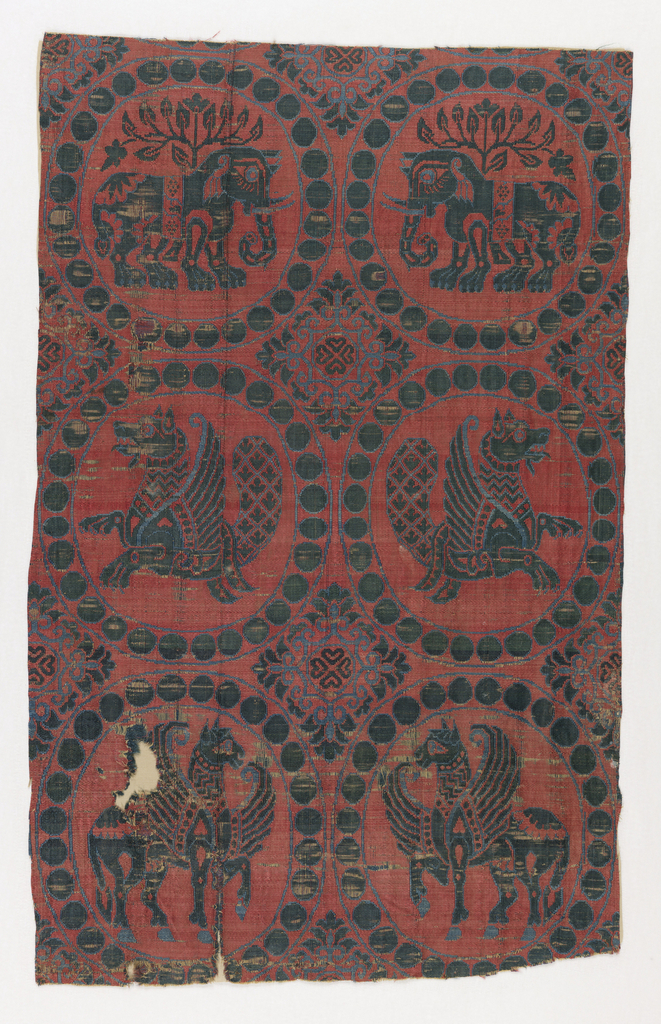
Fragment (Spain, Byzantium, or Eastern Mediterranean), 11th–12th century; Silk compound twill; 51.4 x 32.7 cm (20 1/4 x 12 7/8 in.); Gift of John Pierpont Morgan, 1902-1-222
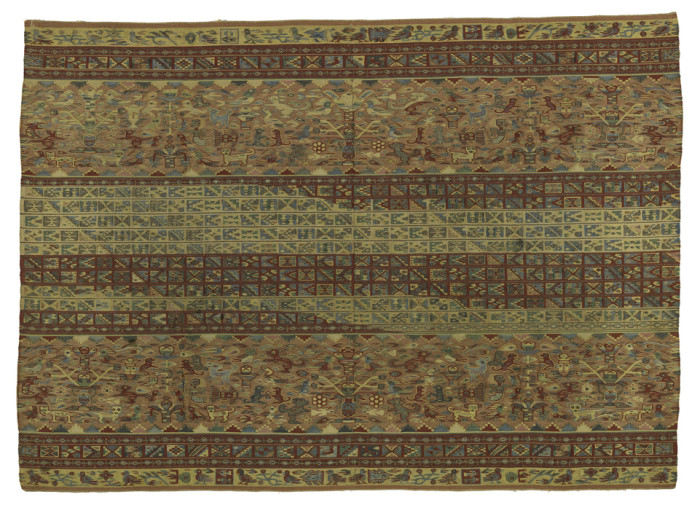
Mantle (Peru), 16th–17th century; Silk and metallic tapestry; 92.7 x 127 cm (36 1/2 x 50 in.); Gift of John Pierpont Morgan, 1902-1-782
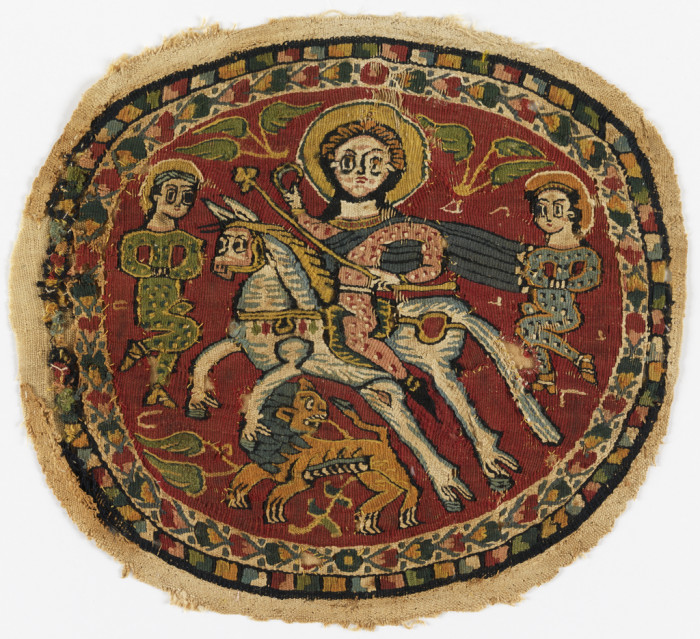
Coptic roundel (Egypt), 6th–7th century; Wool slit tapestry with supplementary weft wrapping in linen foundation; 23.5 x 21.5 cm (9 1/4 x 8 7/16 in.); Gift of John Pierpont Morgan, 1902-1-71
At the time, the gift was valued at $30,000, equivalent to almost $900,000 today [4]. Stanislas Baron was paid 26,000 francs for his collection, and he also acted as the liaison between Morgan and Miquel y Badía’s widow and Antonio Vivès. Baron coordinated the payment to Badía of 100,000 francs for 402 textiles and to Vivès of 28,000 pesetas for 336 textiles. Today, textiles from all three collections have been catalogued and digitized. Through Cooper Hewitt’s website, encounter an Italian fragment of fleur-de-lis, a Ming dynasty rank badge, and a disciple helping himself to the last fish during the Last Supper. To see all objects gifted by Morgan, visit the collection site.
There is still much research to be done on Baron, Badía, and Vivès, but we do have a few facts that explain their interest in antiquities. Badía was a writer, art critic, and collector, whose collection of historic textiles was published in 1900—Collection de Tissus Anciens de D. Francisco Miquel Y Badia (Barcelona). The publication mentions that he was a professor of the History and Theory of Industrial Arts at the Beaux Arts Academy in Barcelona. Vivès started off his education studying medicine, but abandoned this training for business and later became an archivist, librarian, and archaeologist. He was known for his expertise in numismatics, specifically Arabic, and in 1893 he wrote Monedas de las Dinastías Arábigo-Españolas, an important study of Spanish-Arabic coins. Baron was a Paris dealer who began his career as a wine merchant and toured through Spain where he also purchased works of art and antiquities. He soon focused solely on valuable antiquities with an emphasis on Merovingian archaeology.
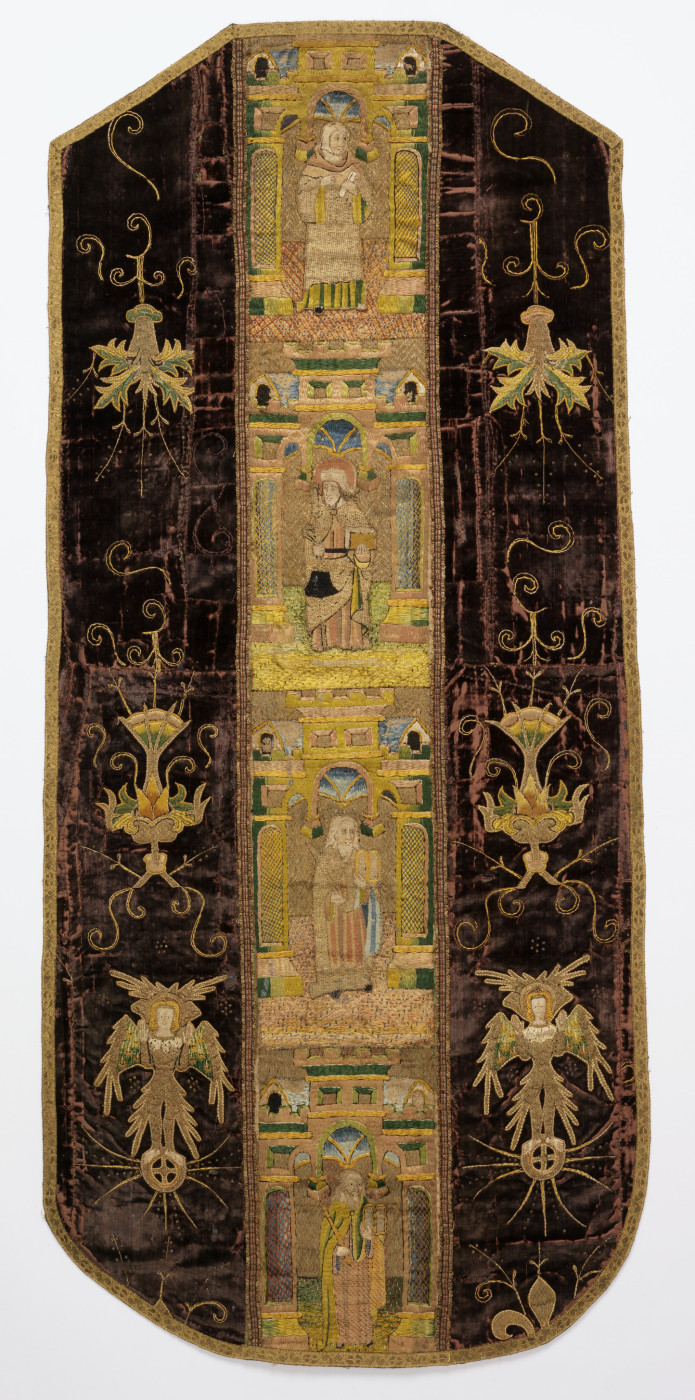
Chasuble back (England), 15th century; Silk cut and voided velvet, appliquéd and embroidered with metallic yarns; 135.3 x 61 cm (53 1/4 x 24 in.); Gift of John Pierpont Morgan, 1902-1-653
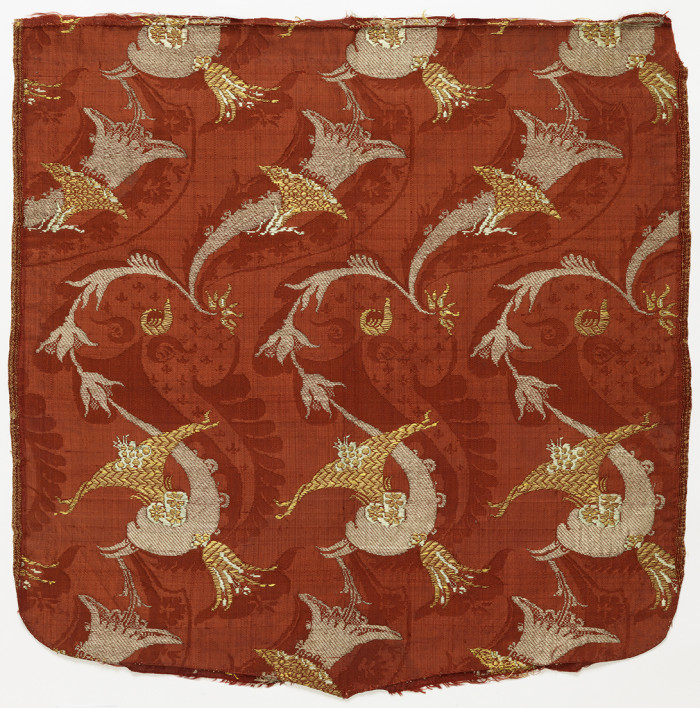
Cope hood (France or Italy), late 17th–early 18th century; Silk satin damask with discontinuous metallic supplementary weft patterning; 52.1 x 50.8 cm (20 1/2 x 20 in.); Gift of John Pierpont Morgan, 1902-1-408
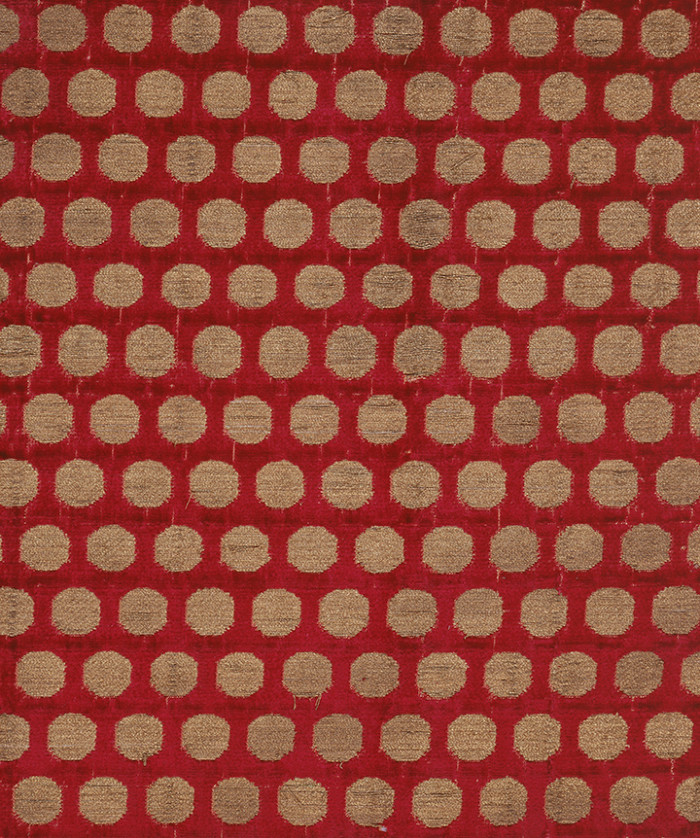
Textile (Iran); Silk velvet with metallic supplementary weft patterning; 53 × 26 cm (20 7/8 × 10 1/4 in.); Gift of John Pierpont Morgan, 1902-1-385
The three collections had worldwide importance, and, soon after their donation to the Cooper Union Museum, several of Baron’s textiles were lent to the Berlin Kunstgewerbe Museum. In addition, there was an exchange of watercolor reproductions of Coptic and Peruvian textiles by students in the design class at the Woman’s Art School for two unnamed photographs from the Chamber of Commerce in Lyons, France. More than anything, this reveals how actively the collection was used for educational purposes. These textiles—along with other objects in the museum’s growing collection—were studied, researched, and even copied in order to learn techniques and ultimately give students the necessary skills for employment in decorative arts professions.
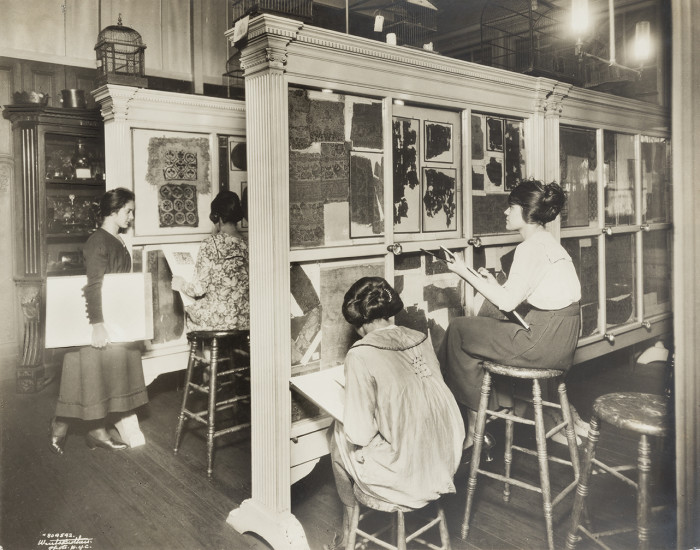
Students of the Woman’s Art School studying the J.P. Morgan collection, ca. 1925.
In the Cooper Union Annual Report of 1903, “Report of the Museum for the Arts of Decoration,” there was an explanation of how the J.P. Morgan gift was going to be displayed in the museum: “These embroideries, brocades and velvets will be displayed, as nearly as possibly, chronologically, subdivided into the various materials and these arranged by country of manufacture, so that the student will have no difficulty in seeing what kind of ornament or quality of material was in use at any period. When the catalogue is finished, these pieces will receive their final arrangement” [5]. One year later, the Annual Report recounts, “the difficulty of procuring dust proof cases, and also reference books from Europe, many of which were out of print and had to be advertised for, [which] has caused considerable delay in exhibiting the J.Pierpont Morgan Collection of Textiles. About half the Collection is shown in the cases which are suitably arranged to be worked from” [6].
These centuries-old textiles are currently conserved and carefully stored in Cooper Hewitt’s facilities. Kira Eng-Wilmot, textile conservator at Cooper Hewitt, describes the practice of storing such delicate pieces:
The objects in this gift are some of the most fragile in Cooper Hewitt’s collection. Most are small fragments that can be stored flat in window mats. The window mats are made of archival boards with a cutout viewing window, layers of different fabrics and tissue papers, and stored in a transparent mylar envelope. The most fragile are stored permanently in a Plexiglass mount. Both types of storage mount provides support and protection for the object, while still allowing for easy and safe accessibility of the object during study, storage, and exhibition.
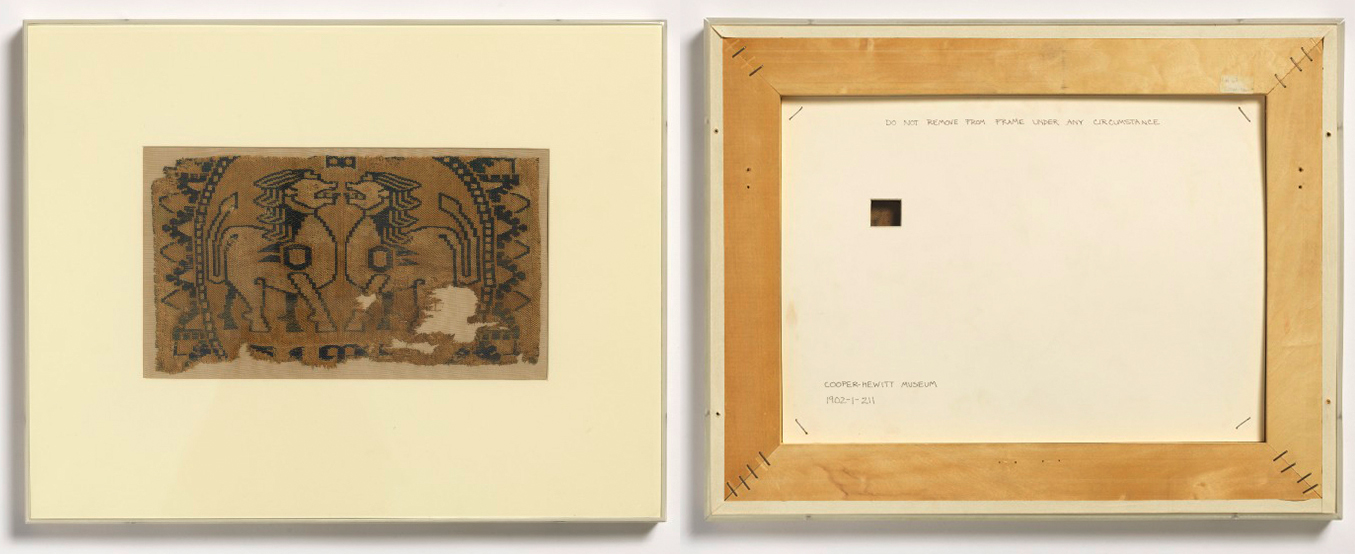
The front (left) and reverse (right) of a permanently pressmounted object. Note the small viewing window on the reverse so that the viewer can still have access to both sides of the object.
The idea formulated early on by Eleanor and Sarah Hewitt that Cooper Hewitt’s collection be used as a laboratory for learning still resonates today as these textiles are continually studied. As the most important collection of textiles ever given to the Cooper Hewitt, Morgan’s gift speaks to his respect for the Hewitt sisters and the museum’s mission to serve a very important educational purpose. In announcing Morgan’s gift in the 42nd Annual Report of the Cooper Union in 1901, there is praise for its superior quality to any other collection in this country, but also recognizes a shared belief by Morgan and the museum for a “profound interest in the diffusion of artistic knowledge” [7].
FOOTNOTES
[1] Eleanor G. Hewitt, The Making of a Modern Museum (1919), 14.
[2] Letter from J.P. Morgan to Abram Hewitt. Seaver Center for Western History Research, Natural History Museum of Los Angeles. Provided by Abraham Samuel Shiff with the permission of Betty Uyeda, Librarian. June 17, 2016. MSS-178.
[3] Hewitt, The Making of a Modern Museum, 14.
[4] This number from an online historical calculator.
[5] Cooper Union Annual Report of 1903 “Report of the Museum for the Arts of Decoration,” p. 108.
[6] Cooper Union Annual Report of 1904 “Report for the Museum for the Arts of Decoration,” p. 47.
[7] Cooper Union for the Advancement of Science and Art. 42nd Annual Report (June 5, 1901), p. 16.
